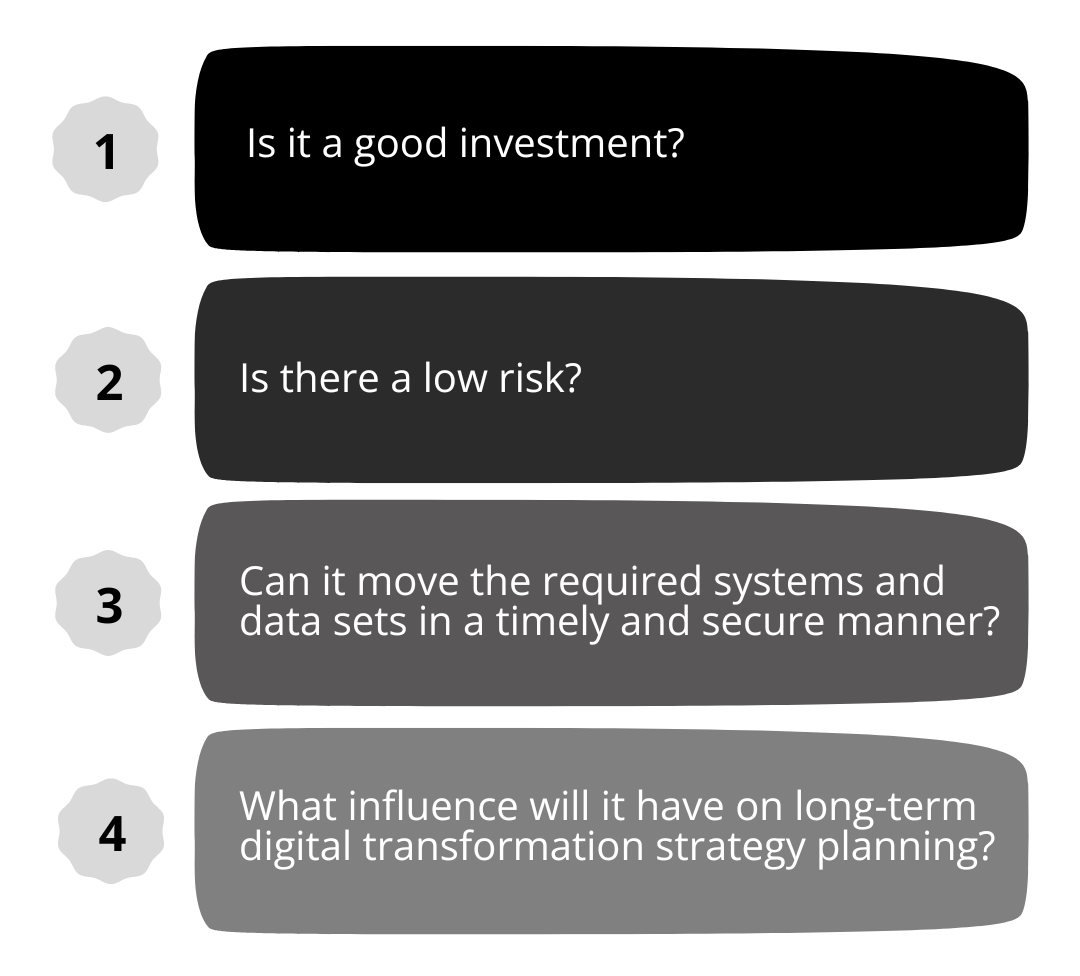Greenfield or Brownfield -What’s Best for Your Organization?

Since SAP declared that it will no longer support SAP ECCs beyond 2027, the necessity to shift to the SAP S/4HANA platform has become even more compelling. Businesses worldwide are already on their SAP S/4HANA Migration journeys, which range from real-time deployment to generating proofs of concept, to drafting the basic planning.
When considering a migration to SAP S/4HANA, the question often arises: which approach—Greenfield or Brownfield —fits best for your organization?
There is no one-size-fits-all solution to SAP S/4HANA migration, there will be some boxes to check regardless. Find it below.
And many more questions will be running in business minds.
Hence, finding an answer that solves all the above questions and satisfies your needs is crucial because SAP S/4HANA plays a significant role in transforming an organization’s business systems and procedures. Each method has advantages and disadvantages, in this writing, we’ll be elaborating on how businesses might be able to negotiate an approach that achieves “the best of both worlds” when transitioning to SAP S/4HANA.
Understanding the Greenfield Approach
What is Greenfield Implementation?
The Greenfield approach to SAP S/4HANA migration involves starting from scratch. It’s like building a new house on an empty lot: you design and construct every element of your new SAP environment without the constraints of previous systems. This approach is typically chosen when businesses want a complete overhaul of their existing systems, often because the current setup is outdated or too complex.
Advantages of Greenfield Implementation:
-
Clean Slate:
You start with a fresh, unblemished system. This allows for a complete redesign of your IT system processes, workflows, and system architecture, leading to significant improvements in efficiency and performance.
-
Best Practices:
You can incorporate the latest SAP best practices and industry standards right from the outset, ensuring that your system is up-to-date and aligned with modern business processes.
-
Enhanced Innovation:
By implementing a new system, you leverage the full capabilities of SAP S/4HANA, including its advanced features like real-time analytics, automation, and new business strategies.
-
Operational Efficiency:
The re-engineering of processes and simplification of workflows can lead to greater operational efficiencies and reduce Total-Cost-of-Ownership (TCO) over time.
Challenges of Greenfield Implementation:
-
Higher Costs:
The cost of Greenfield implementation can be substantial as it involves a significant upfront investment in assessment, planning, and redesign of business processes including [potential infrastructure upgrades.
-
Time-Consuming:
Transitioning to a new system requires careful planning and execution to ensure data integrity and accuracy that no critical processes or data are lost during the migration.
-
Complex Migration:
Transitioning to a new system requires careful planning and execution to ensure that no critical processes or data are lost during the migration.
Ideal Scenarios for Greenfield Implementation:
- When starting from an outdated or heavily customized system.
- If there is a need for a complete overhaul of business processes.
- When aiming to integrate the latest SAP S/4HANA features and innovations without the constraints of legacy systems.
Understanding the Brownfield Approach
What is Brownfield Implementation?
In contrast, the Brownfield approach focuses on upgrading an existing SAP system. It’s akin to renovating an old house while preserving its core structure. This method is used when businesses wish to retain their existing systems and processes while migrating to SAP S/4HANA.
Advantages of Brownfield Implementation:
-
Cost-Effective:
Brownfield implementations are generally less expensive compared to Greenfield ones because they build upon existing systems and infrastructure, reducing the need for extensive new investments in infrastructure or resources.
-
Faster Deployment:
Since it involves upgrading existing systems rather than starting a new one, the Brownfield approach can result in quicker deployment times.
-
Minimal Disruption:
The impact on current business processes is minimal, as the migration is done incrementally with existing processes and reducing the risks associated with large-scale changes.
-
Selective Migration:
Businesses can selectively upgrade components and processes, allowing for a more controlled and phased approach to migration, reducing the risks and complexities associated with a complete overhaul.
Challenges of Brownfield Implementation:
-
Legacy Constraints:
The existing system’s limitations and outdated customizations may constrain the migration process and impact the adoption of new SAP S/4HANA features, potentially limiting the benefits of the migration.
-
Complexity:
Integrating new functionalities with legacy systems can be complex and may require significant effort to align legacy and new processes, which may lead to unforeseen challenges.
-
Limited Innovation:
Brownfield approaches may not fully capitalize the latest advancements in SAP S/4HANA due to the constraints of existing systems, potentially restricting the scope for future enhancements.
Ideal Scenarios for Brownfield Implementation:
- When the existing system is still functional and only requires upgrading.
- If the organization wants to minimize disruptions and costs.
- When there’s a need to retain historical data and customizations while adopting new features.
“According to PwC’s study on SAP S/4HANA transformations, only 14% of companies opted for a full greenfield approach. In contrast, 44% chose a brownfield approach, while 42% preferred a hybrid strategy that combines both methods.”
Greenfield or Brownfield – Which is Right for You?
Making the decision between Greenfield and Brownfield strategies requires a thorough analysis of your current IT environment, business goals, and budget. Here is a table to help you evaluate the best choice between Greenfield and Brownfield approaches based on various metrics:
Criteria |
Greenfield Approach |
Brownfield Approach |
| Definition | New implementation of SAP S/4HANA from scratch | Conversion of existing SAP ECC system to SAP S/4HANA |
| Existing Data | No existing data or configurations are carried over | Existing data, configurations, and customizations are retained |
| System Conversion Prerequisites | Not applicable, as it’s a fresh implementation | Must fulfil all prerequisites for system conversion |
| Phased Roll-Out | Can be implemented in phases or stages, such as by geography or business unit | Typically implemented in a single phase (big bang approach) |
| Complete ERP Renewal | Yes, a complete overhaul of the ERP system | No, the existing ERP system is retained and upgraded |
| Current System Perception | Often seen as an innovation opportunity or a clean slate | Valued for its stability and existing investments |
| Business Process Reengineering | Yes, allows for complete redesign of business processes | Limited, as it retains existing processes and customizations |
| Innovation | High, as it incorporates the latest SAP S/4HANA features and best practices | Moderate, with a focus on new features with existing systems |
| Risk Level | Generally higher due to the scope of change | Lower, as existing systems are leveraged |
| Customization and Configurations | Requires new configurations and customizations from scratch | Existing configurations and customizations are preserved |
| Data Migration | Data migration needs to be executed from scratch | Data migration involves transforming existing data to fit the new system |
| Implementation Duration | Typically, longer due to the complete system setup and configuration | Generally shorter as it builds upon the existing system |
| Examples | Suitable for companies wanting a full refresh or moving from a legacy system | Suitable for companies with stable systems looking to upgrade |
| Cost Considerations | Higher due to new implementations and possible infrastructure upgrades | Potentially lower as it builds on existing infrastructure |
How to Choose the Best Cloud Migration Approach for Your Organization
To help decide which migration strategy suits your organization best, consider the following comparison:
Key Factors |
Greenfield Approach – New Implementation |
Brownfield Approach – System Conversion |
| Do you want to keep your solution enhancements or your transaction data history? | No | Yes |
| Does your system fulfill all conversion prerequisites? | No | Yes |
| Do you need a phased business roll-out? | Yes | No |
| Do you need a renewal of your complete ERP solution? | Yes | No |
| How do you perceive your current system? | Innovation blocker | Key asset |
Deciding between greenfield and brownfield migration strategies hinges on several factors unique to your organization. After outlining your business needs and creating a solid business case, you can determine the most suitable approach, craft a strategy, and develop a roadmap to achieve your goals.
Brownfield projects can be complex, requiring a skilled team to navigate challenges and handle intricate design and testing tasks. Greenfield projects, on the other hand, offer a fresh start and enable you to adopt cutting-edge solutions, but remember that today’s greenfield can quickly evolve into tomorrow’s brownfield.
Still unsure which migration approach is best for your organization?
KaarTech: Your Dependable & Trustworthy Partner
KaarTech, with over 17+ years of experience, is your ideal implementation partner. Our team of over 800+ specialized consultants has successfully guided 70+ SAP S/4HANA transformations and conducted 30+ assessments. We are here to provide tailored advice and ensure a smooth transition to the cloud. Reach out to us for expert guidance and start your journey with confidence.
FAQ’s
1. What is the Greenfield approach to SAP S/4HANA migration?
The Greenfield approach involves starting from scratch with a new SAP S/4HANA system, allowing for a complete redesign of processes and integration of the latest features without constraints from previous systems.
2. What are the main advantages of the Brownfield approach?
Brownfield migration focuses on upgrading an existing SAP system, offering cost-effectiveness, quicker deployment, and minimal disruption by preserving current processes and data.
3. When is a Greenfield approach preferable?
A Greenfield approach is ideal when the existing system is outdated or heavily customized, and there is a need for a complete overhaul or integration of the latest SAP features.
4. How to choose between Greenfield and Brownfield?
Organizations should evaluate their current system’s state, budget, need for a complete ERP renewal, and desired level of innovation when deciding between Greenfield and Brownfield migration strategies.



